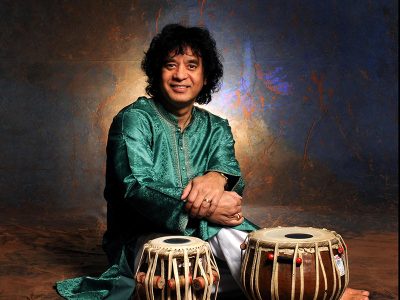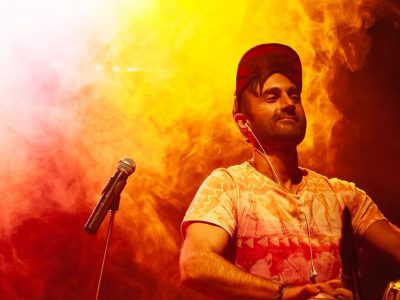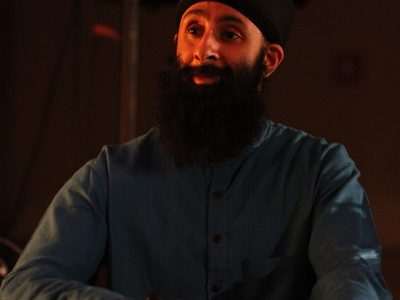- News
- UBC School of Music’s Eshantha Peiris on Zakir Hussain
UBC School of Music’s Eshantha Peiris on Zakir Hussain
The Chan Centre partners with the UBC School of Music’s Department of Ethnomusicology to engage students in writing short pieces connecting our presentations to pertinent ideas and concepts in ethnomusicology. Here, graduate student Eshantha Peiris writes about the importance of Zakir Hussain’s music in a cultural and political context.
Eshantha Peiris is a student of ethnomusicology at UBC. As a musician, he has performed and recorded albums with the bands Thrilōkā, Båliphonics, and Serendib Sorcerers. His recent solo piano album Global Rhythms Reimagined can be heard at eshanthapeiris.com.
Zakir Hussain and the Evolving Tradition of Tabla Music
What we know of today as “Hindustani classical music” has its roots in the North Indian feudal palaces of the British colonial era. The decline of the feudal patronage of music in the early 1900s (memorably portrayed in the Satyajit Ray film The Music Room), coupled with the advent of recording technology and the democratization of Indian society, saw many court musicians having to adjust from a secluded, elite lifestyle dedicated to music to having to meet the entertainment expectations of a concert-attending general public. Amplified performances of shorter duration with greater musical variety, innovation, and virtuosity became the norm, though the music still retained a balance between fixed and improvised elements. A global demand for Indian music in the 1960s – driven by a western appetite for an exoticized Orient – spurred further changes to the genre, with the emphasis shifting from sung devotional content to purely instrumental music. The expanding market for “world music” in the 1980s coincided with an increase in deliberate “fusion music” projects, which lead to further transformations in the performance styles of North Indian instruments.
Tabla icon Zakir Hussain’s own stylistic heritage (the “Punjab gharānā”: a teacher-student lineage of oral learning), while steeped in tradition, has been at the forefront of innovation in tabla-playing throughout the past century. Inheriting the virile rhythmic vocabulary of the pakhawaj drum, tablists of this tradition were well-equipped to elevate the status of the tabla from an accompanying drum to a recognized solo instrument in the 1940s. Practising their art more or less independently from the theory-based approach of the formalized Hindustani music schools which proliferated in post-independence India, these musicians were able to introduce dramatic changes into the tradition without needing to challenge a written historical authority. Alla Rakha Khan (Hussain’s father) became well-known internationally both for his association with sitarist Ravi Shankar, and for his expanding of rhythmic techniques to unprecedented levels of complexity. And since the end of the 20th century, Hussain himself has spearheaded collaborations with jazz, rock, electronica, Carnatic, Japanese, and – most recently – Celtic musicians, pushing the geographical and musical boundaries of tabla music, and in the process helping to establish the tabla as a transglobal cultural phenomenon.
Although his current roles as touring performer, recording artist, teacher, and record-label executive have no doubt increased the visibility of the tabla as a versatile instrument in today’s global musical environment, Hussain has been quick to acknowledge: “I think that my contribution can only be that I have helped it [the tabla] to be globally available. And people all over the globe who are embracing it are actually changing the way it looks because it is becoming part of their vocabulary and therefore it is becoming a tradition with a language that is more universal.”
Sources:
Gottlieb, Robert S. Solo tabla drumming of North India: its repertoire, styles, and performance practices. Vol. 2. Motilal Banarsidass Publ., 1993.
Ruckert, George E. Music in North India: Experiencing Music, Expressing Culture. New York: Oxford University Press, 2004.
Neumann, Daniel. “A Tale of Two Sensibilities: Hindustani Music and its Histories.” In Theory and Method in Historical Ethnomusicology, edited by Jonathan McCollum and David G. Herbert, 279-308. Maryland: Lexington Books, 2014.
Nuttall, Denise. “Tracking the Intercultural Borders, Fusions, Traditions and the Global Art of Tabla.” Journal of the Indian Musicological Society, January 1, 2011.



